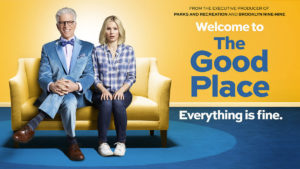Anyway, season one we are introduced to the core characters and a smattering of reoccurring one. The program’s lead is Eleanor Shellstrop a vain, self-centered, damaged woman who awake to discover that due to a mistake she has been slotted to spend the afterlife in ‘the Good Place.’ Along with Eleanor we meet Chidi, a
Senegalese professor of moral philosophy and Eleanor’s soul mate, Tahani Al-Jamil, an international socialite and philanthropist and her soul mate played by Manny Jacinto. In addition to these four human characters there are two addition eternals to the cast, Janet a universal storehouse of knowledge and Michael, played by Ted Danson, the architect of the afterlife neighborhood where the characters will be spending eternity.
Season One focuses on Eleanor and the strange occurrence and eventual explanation for what a woman who had not lived a good life has landed in the Good Place. When the season concludes the final revelations would seem to indicate that the creators had boxed themselves into a situation that had played itself out.
Season Two Focuses on Michael and the gulf between his eternal nature and understanding what it means to be human. Creating an entirely new dynamic for the series while retaining the characters and their essential natures. Again when the season reaches its conclusion a radical transformation of the situation creates an entirely new set-up.
Season Three returns the characters to Earth, no longer in the afterlife, and dives further into the essential questions explored throughout the series, what does it mean to be good? How can a person be good? Deep questions that the shows investigates and interrogates through philosophy and comedy making it the smartest dumb show on television.
Now with the third season wrapped and the program returning to its original roots but from a decidedly new perspective, The Good Place has reinvented itself once again and yet remained true to its central premise and theme. Not since Vince Gilligan’s Breaking Bad have I seen a show that so utterly committed to transformation and yet never lose track of what it is supposed to be about.
If you are not watching The Good Place, catch up with Netflix and discover what you have missed.

